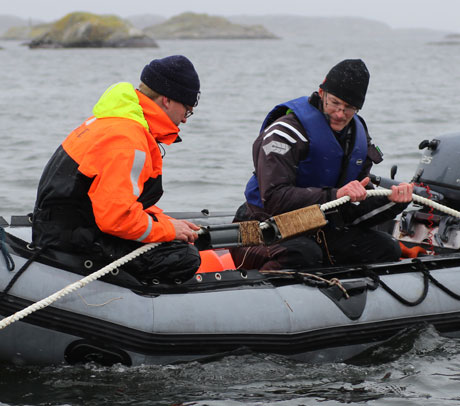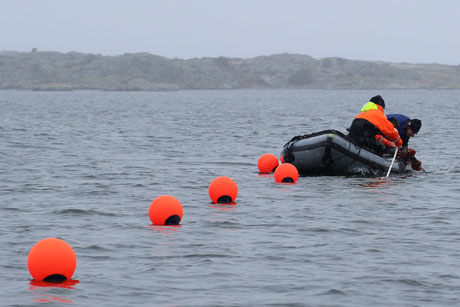Seaweed Farm Deployed at Sea
The first plants of brown algae are now deployed close to the Koster Islands in northern Bohuslän. They are part of a transdisciplinary research project aiming at cultivating seaweeds and using substances from them.
The first plants of brown algae are now deployed close to the Koster Islands in northern Bohuslän. They are part of a transdisciplinary research project aiming at cultivating seaweeds and using substances from them.
In autumn 2013 scientists collected plants of the brown algae sugar wrack (Saccharina latissima) and allowed them to reproduce in the laboratory at the Lovén Centre Tjärnö. After almost three months of indoor cultivation, the juvenile plants have now been deployed in the sea for further growth. Maximum growth of sugar wrack is in early spring, and in May 2015 the plants may have grown to a length of 2 metres.

The scientists Gunnar Cervin and Göran Nylund deploy tiny plants of the brown algae sugar wrack on long-lines which is lowered to 1 and 4 metres depth.
– We collected the parental plants at 1 and 4 metres depth, and we have lowered the small plants at the same two depths, says Dr. Göran Nylund at the Department of Biological and Environmental Sciences. We will regularly sample to measure growth and to analyze the chemical content in the algae.
The scientists have a permit to cultivate seaweeds in Kosterhavet Marine National Park, west of Lådderskären and north of Vedskär. Later on the brown alga relative oarweed (Laminaria digitata) will also be cultivated.
The cultivation of seaweeds is part of the transdisciplinary research project Seafarm. In other parts scientists examine whether the brown algae can be utilized in food, feed, paper, plastics, rubber and textile fabrics, as well as transformed to bioethanol and biogas. The expectation is to create conditions in Sweden for large-scale seaweed cultivation and utilization of the algal content. The project will run for at least 5 years.

The first seaweed farm is located west of Lådderskären in the Kosterhavet Marine National Park.